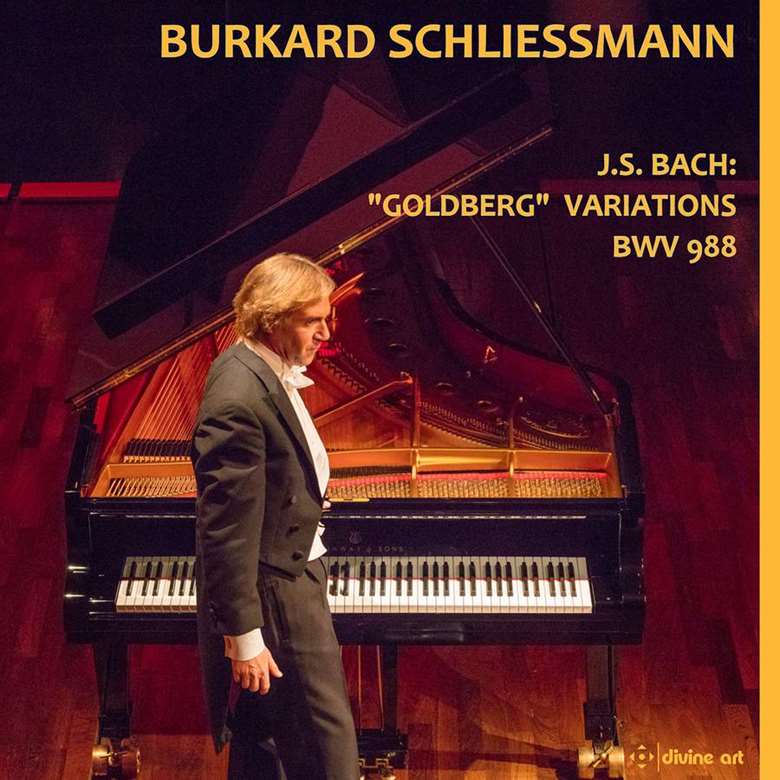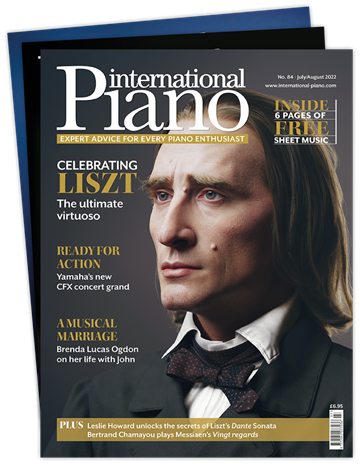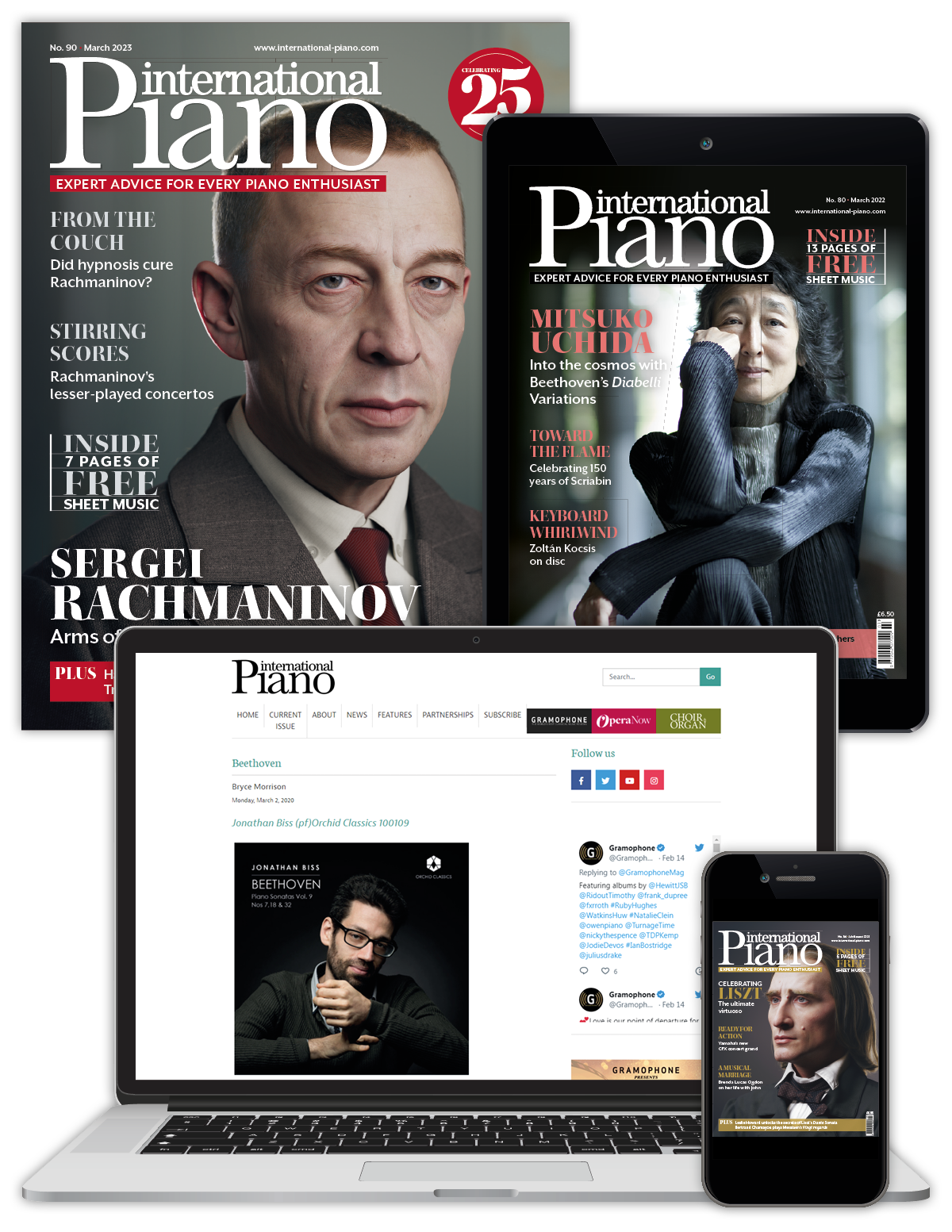‘Time, space and magic’: Burkard Schliessmann plays Bach’s ‘Goldberg’ Variations
Owen Mortimer
Tuesday, August 23, 2022
Owen Mortimer in conversation with Burkard Schliessmann about his interpretation of Bach’s ‘Goldberg’ Variations, BWV 988, released on Divine Art

You've written that Bach's Goldberg Variations combine ‘rigour and order’ with ‘inner and outer lyricism’. How do you strike the right balance between these qualities in performance?
Indeed, the interpretation of the Goldberg Variations is one of the greatest challenges of the piano repertoire. One has to respect that the Goldberg Variations have always enjoyed a special status, with pianists regarding them as a touchstone of their technical and interpretative powers. At stake are the ability to light up the work from within – to draw together a vast circle that starts out and returns to a state of stillness – and to find one’s bearings with an inner and outer coherence and homogeneity. The performer must play a game with particular devices, finding solutions to the problems posed by the work, not only technically but in a tightly structured inner rigour and order. What is demanded is a particular form of internalisation, of inner and outer lyricism. It is this that makes the Goldberg Variations unique – and so demanding.
As for the genesis of the work, we know only what we have been told by Romantic biographers, and the truth or otherwise of these accounts is hard to substantiate or refute. When Bach prevailed upon Balthasar Schmid of Nuremberg to publish his Goldberg Variations in 1742 as Part Four of his Clavier-Übung, he held the title of Court Composer to the King of Poland and Elector of Saxony, a title that had been conferred on him in 1736, largely on the recommendation of Baron Hermann Carl von Keyserlingk. Keyserlingk had been appointed Russian ambassador to the Dresden court by Catherine the Great in 1733, in which capacity he actively championed the finest instrumentalists of his day. One such performer was the exceptionally talented harpsichordist Johann Gottlieb Goldberg (he himself preferred to be known as Theophilus). He was born in Danzig in 1727 and initially studied in Dresden with Bach’s eldest son, Wilhelm Friedemann, but on Keyserlingk’s recommendation he moved to Leipzig in 1740 and took lessons with Bach himself, the exceptional virtuosity of his playing causing a sensation in spite of his tender years. The outward circumstances of the work’s composition seem to us to be unimportant and do nothing to alter the monumental significance of the piece. Whether true or not, these anecdotes serve to surround the Goldberg Variations with an aura of mystery.
Each variation is strongly characterised yet fits into a tightly conceived structure. What challenges does this pose to the interpreter? In particular, how do you determine the tempo relationships between each variation?
The interpretation of the entire work must take be governed by a single pulse, not from a classical top-down view, but as a dynamic process. The Goldbergs must be seen as a one big whole!
This work comes from Bach's ‘late’ period and reflects his interest in philosophy and mathematics, notably the medieval concept of ‘musica speculativa’. How is this manifest in Bach's writing?
Bach’s music forms a bridge: while it is rooted in the past in terms of its form and spirit, the bold treatment of musical material also point forwards to future musical periods. Ever since Bach’s works were rediscovered by the Romantics in the early 19th century, the composer has been admired and hailed as a timeless musician. It is hard to put into words the special quality of his music. Bach never spoke about himself or his own sufferings and pleasures; his calling was sustained by a profound artistic and intuitive musical understanding and the impact of the melodic line, which he had inherited from the age of Renaissance polyphony. With his unsurpassed ability to create thematic material, Bach contrasted the older style with the newer Classical art, with its added dimension of humanity. As the mouthpiece of a higher power, he was the medium of religious revelation in his sacred works, the servant of social conventions in his secular suites and the executor of musical developments in ‘free’ compositions that were not tied to a particular purpose, most notably the preludes and fugues of The Well-tempered Clavier. In short, Bach’s incomparable greatness rests as much on his genius as on his position and function within the history of music.
Bach’s works are remarkable for a synergy arising from many different currents, a quality inspired by the past, starting with vocal polyphony. The power associated with the independent melodic line, the primal power and impulse of all music-making continues unbroken in his music, filling his fugues with their uninterrupted thematic momentum. The architectural spirit of Gothic art is manifest in Bach’s forms, achieving a sense of fulfilment that seems like a reminiscence. Such forms are like bold and fantastical buildings in the imaginary space of their sound world, thereby acquiring a genuine weightlessness and timelessness. The legacy of an age that was religious in its inspiration lies primarily in the unique contribution of the transcendental, which is achieved through mystic contemplation and ecstatic uplift.
The Goldberg Variations may be said to usher in this late period. As the most marvellous example of Bach’s late style, they are sustained by a lightness and consummate freedom in their part-writing that could be based only on Bach’s towering command of compositional technique. The sequence of canons that determines the work’s elaborate overall structure attests to an extraordinary engagement with the material, allowing us at the same time to conclude that the recipient of the work, Count Keyserlingk, was not only a music lover but also a connoisseur. The great 16th-century scholar and theorist Gioseffo Zarlino (1517–90), who was the first to define the major-minor system, described canon technique within the framework of his theory of counterpoint, treating it as a type of composition that was not very common at that time: ‘He who will first exercise himself in this simple manner of composing may afterwards go on easily and quickly to greater things […] He will be able to go on to compositions for more voices, so that, aided by our directions and by his own talents, he will in a short time become a good composer.’ In his 1753 treatise on fugal practice, Friedrich Wilhelm Marpurg – frequently described as ‘the greatest music theorist in Europe’ – noted that in the 17th century canon technique was increasingly seen as the ‘touchstone for a composer’s skill in harmony’. At the same time, the canon was held up as a mirror of the heavenly liturgy of the Sanctus, which was said to be endless – ‘sine fine’. As such, it acquired an almost spiritual significance.
Canonic techniques acquired a new importance in 1741/2 thanks to Bach and his Goldberg Variations and left their mark on all the Thomaskantor’s works between then and his death. The canon assumed a new autonomy and was no longer merely a mysterious salutation or a dryly academic exercise but raised works such as the Canonic Variations for organ, the Musical Offering and the Art of Fugue to a new level of visionary expressionism. Bach’s intense engagement with this technique and the links with some of his other works were confirmed by a spectacular discovery in Strasbourg in 1974, when the composer’s own personal copy of the Goldberg Variations came to light. It not only contains Bach’s manuscript corrections to the printed score (corrections already mentioned by Forkel), but the back inside cover includes a further 14 canons, also in Bach’s handwriting, ‘on the first eight notes of the ground of the preceding aria’ (BWV1087). One of these canons (No 11) was entered by the composer in the album of the Leipzig divinity student Johann Gottfried Fulde in 1747, while another (No 13) appears as the ‘Canon triplex a 6 Voc.’ in Elias Gottlob Haussmann’s 1746 portrait of Bach. This last-named canon was subsequently printed for Lorenz Christoph Mizler’s Correspondirende Societät der Musicalischen Wissenschaften. In both canons the bass line of the Goldberg Variations is clearly identifiable. The affinities between the canonic techniques found in these Fourteen Canons and the Canonic Variations on Vom Himmel hoch BWV769 for an organ with two manuals and pedal emerge not least from the fact that the beginning of the bass line of the Goldberg Variations is the same as the melody of the traditional Lutheran Christmas hymn. This same bass line is also found in the Sarabande in the Notenbüchlein for Anna Magdalena Bach.
In the case of the Goldberg Variations, the Aria determines the structural design from its first note onwards. Contrary to expectations, this Aria does not provide the usual sort of thematic material that is then subjected to increasingly elaborate variations throughout the rest of the work. Instead, the Aria provides the first statement of the bass line before Bach starts to deploy variation technique. It comprises a passacaglia made up of four eight-bar periods and determines the whole of the rest of this 30-part network of variations. The autonomy of the richly decorated soprano line that is built up over it is symptomatic of the quality of the work as a whole.
Bach’s music would have originally been played on a harpsichord. Do you draw on performance practice traditions associated with early keyboard instruments when playing this work on the piano?
No, absolutely not. If one already has crossed the border from the harpsichord to the concert grand, one must also accept the ‘modernity’ of the concert grand and its way of playing, sound world and the associated challenge of a completely new interpretation. Of course, not to be misunderstood, there really are laws of execution, for example ornamentations and other basics of style that must be respected! Otherwise, it would collide with my respect for the truth in the most decisive way. It is a question, and an art, of finding the right balance between historical performance practice and the modern concert grand.
Which edition of the Goldberg Variations score do you favour, and why?
For the study of such a monumental work, it is essential to consult the ‘Neue Bach-Ausgabe’, published by Baerenreiter, Leipzig, based on the Johann Sebastian Bach Institute, Göttingen and the Bach Archive Leipzig.
As an ‘Urtext edition’, the New Bach Edition offers scholars a reliable musical text that serves musical practice in the same way. With its editions compiled according to the strictest philological methods, the New Bach Edition has set standards for modern critical scholarly editing in the second half of the 20th century. The work on the New Bach Edition has led to new discoveries of lost compositions and has been able to clarify questions of authenticity in the known body of works. In particular, however, the examination of the sources for Bach’s works has led to a far-reaching correction of the chronology and thus at the same time created the basis for the revision of Bach’s image in our time.
In addition to a preface, the music volumes contain a selection of facsimiles of the relevant sources. Each volume of music is accompanied by a separate Critical Report, which describes all the surviving sources for a work and their interdependence, and also provides all reliable data on the composition's genesis. In addition to the complete surviving works, the volumes of the individual series also contain surviving fragments.
But I also appreciate the ‘Wiener Urtext Edition’. Since its foundation in 1972, Wiener Urtext Edition has established itself as a pioneering publisher of scholarly, performance-informative and practice-orientated Urtext editions with its excellently researched and edited editions. The philosophy of the ‘Wiener Urtext Edition’ is a scholarly-critical edition for practical use and differs from many other Urtext editions by providing comprehensive textual information in German and English (partly also in French).
The preface provides information about the work, its genesis, music-historical significance and tradition. Despite the necessary brevity, the Critical Notes give a clear account of the sources and editorial decisions. The notes on interpretation help the musician to perform the music according to the performance practice of its time of origin. The musical text itself is edited on the basis of a precise examination of all sources by renowned musicologists. Well-known musicians and pedagogues contribute fingerings and appliqués.
What do you mean when you say this music is 'without a beginning and an end'?
‘Virtuoso development out of silence and transcendental concealment in apotheosis’ – so an excerpt from my headline of my programme note to the Goldbergs. In the performance history of the Goldberg Variations, Rosalyn Tureck, Wanda Landowska and Glenn Gould were all pioneers who set new standards in the work’s interpretation. In his booklet notes to his 1955 recording, Gould wrote that ‘It is, in short, music which observes neither end nor beginning, music with neither real climax nor real resolution, music which, like Baudelaire’s lovers, “rests lightly on the wings of the unchecked wind”.’ Gould is referring here to the circular design of the work, a circularity whose development is polarised, inspired and fed by more and more new energy fields. The result is a universe which in its significance resembles the alpha and omega of music in general, music that evolves out of nothing and disappears back into nothing as if in a state in which time stands still.
How do you feel after performing Bach's monumental work? And what impact do you hope it leaves on your listeners?
The vast area that this work covers in terms of its emotional and intellectual development is simply awe-inspiring, generating a force that, constantly renewed, resembles a perpetuum mobile whose source of energy never runs dry. As a result, the residual secret of creative endeavour was always to be left to the imaginary world of intuition, moving and astonishing performer and listener alike.






